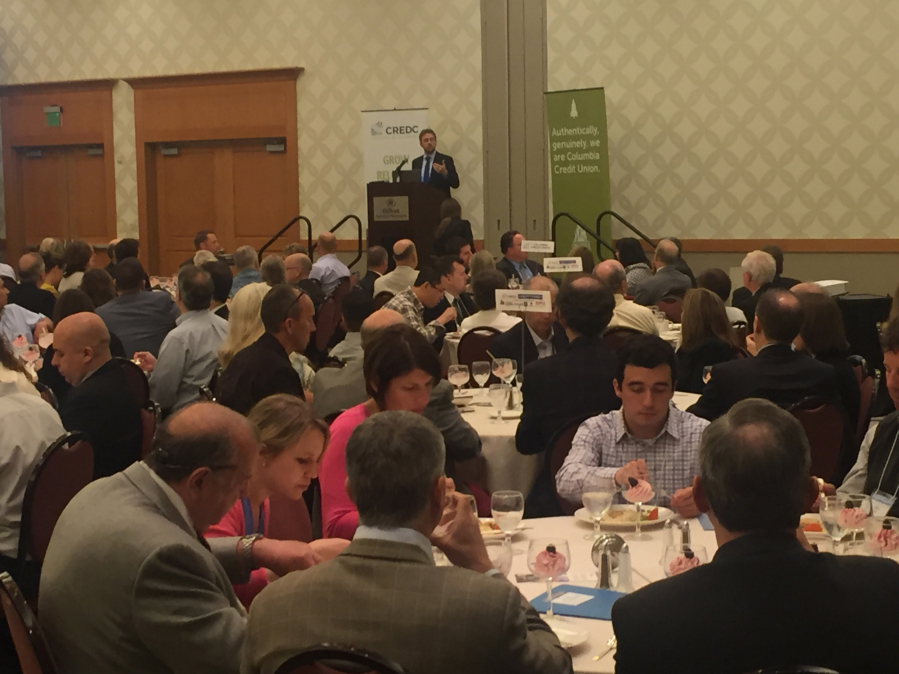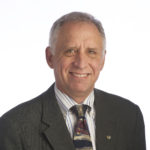A top economic analyst offered a generally positive short-term picture of both U.S. and global economies Thursday as part of a two-day regional economic conference at the Hilton Vancouver Washington.
With the American economy, “the fundamentals are strong and the headways are also strong,” said Greg Daco, head of U.S. macroeconomics at Oxford Economics, a global research and analysis firm.
Those headwinds, Daco told a luncheon audience, include weak economies in emerging world markets that buy U.S. goods, the potential for further declines in oil prices, and the possibility that an increasingly strong dollar could weaken U.S. price competitiveness.
The outcome of this year’s U.S. presidential election also could have an effect on the economic outlook because of the uncertainty of how candidates’ economic policy proposals will play out.
“Uncertainty hurts the economy,” Daco said.
The luncheon presentation was hosted by the Columbia River Economic Development Council in coordination with the Pacific Northwest Regional Economic Conference. That conference, now in its 50th year, has brought dozens of experts from the Western U.S. and Western Canada for highly technical panel discussions on numerous regional topics.
Daco predicted a very low risk that the U.S. would enter into a recession in the next six to 12 months, but forecast that economic growth in the U.S. and worldwide is likely to be lower than long-term averages. The U.S. gross domestic product would grow by 2 percent or less, he said, with the world economy growing by about 2.3 percent.
However, the world’s emerging markets excluding China might grow by only about 1.7 percent, Daco said. He singled out Brazil as a nation with major economic and political issues that are dragging down its once-booming economy. And Japan, expected to grow its economy by just 0.5 percent, faces the challenge of fending off price deflation that discourages consumer spending, he added.
Daco pointed to the Canadian economy as one displaying wide regional differences in economic health, with British Columbia leading the way and oil-dependent Alberta in a period of financial stagnation. An economic stimulus program launched by new Canadian Prime Minister Justin Trudeau is stimulating the nation’s economy, which is expected to grow by 1.5 to 2 percent.
While the rapid rise in housing prices has emerged as a key issue in the Portland-Vancouver metro area, Daco said housing on average remains affordable in the U.S. The Western United States is a hot spot for housing price increases that exceed inflation, he said.
In response to a question from Sen. Ann Rivers, R-La Center, about the impact of local increases in the minimum wage to $15 an hour, Daco said the increases could help the economy if they result in increased spending at affected businesses. “I think it’s a positive thing as long as it’s not sudden,” he said of the wage increases. “A gradual increase is a great move.”
Highlights from other speakers at Thursday’s event:
• Portland State University Ph.D. student Kirstin Munro shared her research on employment in the software industry in the Portland metro area. She found that 71 percent of software workers are male, and women in the field face a 45 percent wage penalty. “Portland is one of the worst (metropolitan statistical areas) for the software wage gap,” Munro said.
• John Burbank, founder of the Economic Opportunity Institute, showed that Washington state’s median wage has grown from $18.80 in 1979 to $19.41 in 2015. That flat wage trend hurts women and minorities the most, he said, and pointed out the 50 percent of the state’s income was earned by the top 10 percent of earners last year. “We are either passive or active in … the growing inequality in our cities and states,” Burbank said.
• Tyler Mac Innis, an analyst at the Oregon Center for Public Policy, said the average Oregonian — a 39-year-old woman who makes $33,000 a year — would be making $78,000 per year if her wages grew at the same rate of the top 1 percent of earners in the state. He stressed that inequality has widened with the decline of unionization and said increased inequality slows overall economic growth.
Columbian reporter Brooks Johnson contributed to this story.




